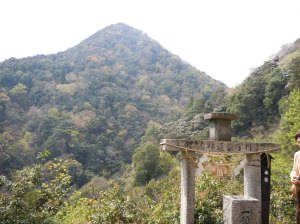
Himurogatake, Kyoto (c) 2013

Kuromantayama (c) 2011
The information below on pyramid mountains and pyramid rituals is from: http://www.geocities.jp/mb1527/N3-01-1hidakoku.html.
*
日本ピラミッド Pyramids of Japan
In Hinomoto (old name for Japan) there are mountains that are said to be pyramids. Among them, on and around mountains, are 岩石祭祀遺構 boulder ritual remains. Fourteen of these pyramid mountains (and prefectures) are listed here.
大石神 Ooishigami(青森県 Aomori)・黒又山 Kuromantayama(秋田県 Akita)・
五葉山 Goyouzan(岩手県 Iwate)・千貫森 Sengenmori(福島県 Fukushima)・
尖山 Togariyama(富山県 Toyama)・位山 Kuraiyama(岐阜県 Gifu)・
石巻山 Ishinomakiyama(愛知県 Aichi)・東谷山 Tougokusan(愛知県 Aichi)・
三上山 Mikamiyama(滋賀県 Shiga)・三輪山 Miwayama(奈良県 Nara)・
日室ヶ嶽 Himurogatake(京都府 Kyoto)・葦嶽山 Ashitakeyama(広島県 Hiroshima)・
弥山 Misenyama(広島県 Hiroshima)・野貝原山 Nogaiharayama(広島県 Hiroshima)
[An annotated list of the above 14 pyramids and prefectures follows, not presented here. Then the text continues as below.]
To Hida from 越中国 Etchu province were conveyed many traditions that differ completely from other regions. These lore may seem to be occult as not many are in the academic tradition. However, they were spread from the nucleus of the region. Let us consider whether there is something here to become the nucleus, without being negative at the beginning.
ピラミッドは縄文祭祀 Jomon pyramid ritual
The center of the ritual is a pyramid. The Japanese pyramid is a mountain whose nature was modified by arranging the boulders; it is believed to have been used in sun rituals. There are many pyramids in East Japan where there are Jomon ruins in the vicinity. It is thought that these represent rituals of Jomon people. The Hida hidaki no mitama shizume ritual of Takaamahara is part of a sun faith. It was active at the time of Nigihayahi-no-Mikoto until the Yayoi era. Although he unified the Tokai and Kanto regions, they are a coastal area, whereas usually Jomon ruins are found close to mountains. Mononobe clan were settlers from along the Osaka Bay who made Yayoi settlements near the coast, and segregated from the Jomon people. Then they began to mix peacefully without friction.
However, that was not the case in inland areas. Jomon people made their sun faith using megalithic pyramids, so when Yayoi people tried to enter their land, friction arose. Shinano province struggled during the unification. Hida province is also a mountainous area and farming area is limited. The Jomon of Hida did not easily accept the unification.
Hida Takaamahara is believed in the lore to be the oldest dynasty in Japan. It can be argued that the Jomon people made a country in Hida. The Jomon people had flourished along Nyukawa with Norikuradake as their symbol. Because of climate change, they moved closer to Kuraiyama. The Jomon nation lasted for over two thousand years. Their stories became legends in Takenouchi and Hotsuma documents.
Hida is still a region where many have inherited the blood of Jomon. Jomon people were living in the mainstream, then the Yayoi people entered. The Jomon did not have any people referred to as king. However there were leaders in Hida that were called 上方様 Uakatasama, who probably led rituals mainly in the Jinzu river basin.
When did the Hida kingdom exist? It is completely unknown. It has been reported that the center moved, due to climate change, from around Norikura to around Kuraiyama. Since the great climate change for Jomon is about 4500 years ago, it may have been around that time. In the Takenouchi document there has been a Ugaya dynasty of 72 generations before Jimmu Tenno. In the Kuki document there has been a 1200 year history of 72 generations. Ugaya may have been written down in place of the Hida dynasty. As more and more people flowed in during the Yayoi era, the Hida people faced confrontation.
*